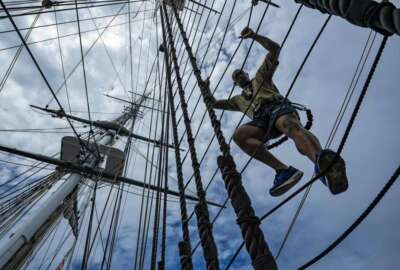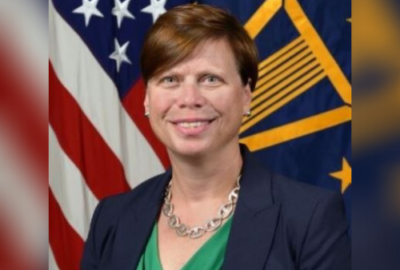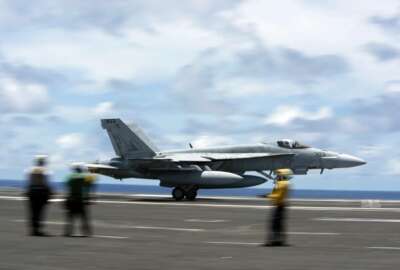
Celebrating 78 years of one of the Navy’s most active forces
The Navy is celebrating the 78th anniversary of Naval Air Force Atlantic. 78 happens to be the hull number of the Navy's newest aircraft carrier, the U.S.S. Gerald...
Best listening experience is on Chrome, Firefox or Safari. Subscribe to Federal Drive’s daily audio interviews on Apple Podcasts or PodcastOne.
The Navy is celebrating the 78th anniversary of Naval Air Force Atlantic. 78 happens to be the hull number of the Navy’s newest aircraft carrier, the U.S.S. Gerald R. Ford. Since its formation in the middle of World War II, Naval Air Force Atlantic has fought in every American conflict. With highlights of that rich history, its commander Rear Adm. John Meier joined Federal Drive with Tom Temin.
Interview transcript:
Tom Temin: Admiral Meier, good to have you on.
Rear Adm. John Meier: Well, it is great to be here. Thanks for the opportunity to chat today.
Tom Temin: And 78 is kind of a neither here nor there year. It sounds like it’s something you celebrate every year.
Rear Adm. John Meier: Yeah, it is. We recognize this every year. It’s not necessarily a round number like a centennial. But 78 is kind of a special number as I was the first CEO of Gerald R. Ford. And we take that opportunity to recognize not only the anniversary this year for Naval Air Force Atlantic, but also the really the advance of the Ford class carrier, which has been such a workforce for us here on the East Coast doing carrier qualifications. And most recently, you joined us at sea for cyclic operations just last month.
Tom Temin: Yeah, that was a real treat, I have to tell you, and I can’t get over how good the cookies are that they make on board. I imagine it’s hard to keep your waistline if you spend too much time on a carrier like that.
Rear Adm. John Meier: Well, those cookies are dangerous. And I’ve generally got a rule that I won’t eat them. I know how good they are and it’s very hard to stop at just one.
Tom Temin: Alright. And Naval Air Force Atlantic interestingly it started in the middle of World War Two in 1943. And it has the term Air Force before there was an Air Force. So you might say Navy was first to have an Air Force.
Rear Adm. John Meier: That’s an interesting point. I hadn’t thought of it that way. But it was certainly born as a response really to the Battle of the Atlantic, and the U-boat war that was going on off our coast. I mean, right up against our coast. And early in the war, the German Navy was incredibly successful with their U-boats almost choking off our ability to resupply our allies and to ship goods to and from.
Tom Temin: And what about, in modern times, the Air Force Atlantic has been as far distant as Afghanistan and Iraq.
Rear Adm. John Meier: It has. So today, Naval Air Force Atlantic is more of a manning, training, equipping command. So we do have a limited operational role. But primarily, we produce ready forces. So we focus on current readiness and the development of those forces such that they are handed over to the operational commanders, and then deploy literally around the world. We actually have commands from our claimancy here that deploy to the west coast. We just sent two squadrons that way, they’ve got underway with Theodore Roosevelt. But mostly it’s focused on the East Coast and carriers and operations that are departing from here going eastward.
Tom Temin: And give us a sense of the extent of the assets that are under the Atlantic Air Force, that is to say, ships and planes and people.
Rear Adm. John Meier: Well it’s a pretty sizable portfolio. Right now we have all of the East Coast aircraft carriers, and the carriers that are in refueling and maintenance. We’ve got two shipyards that are here. So currently we have six aircraft carriers here on the East Coast. We have roughly 45,000 personnel throughout that. So we have two carriers that are associated air wings, the P-8 community based down in Jacksonville, Florida. We have H-60. Romeos also based in Jacksonville, H-60. Sierra’s here, H-53s here in Norfolk, and Oceana is our master jet base has all of our F-18 aircraft here on the East Coast. E-2D aircraft and the E-2 Training Squadron is here in Norfolk as well. And we continue to see expansion of our air wing. So the air wing, as you know, has not been static. It’s evolved since the inception of naval aviation. And we’re on the brink right now of bringing unmanned aerial vehicles. We’ve got the MQ-8 Bravo which we’ve been flying for a while. And right now HSC-22 is transitioning to also fly not just the H-60. Sierra, but the MQ-8 Charlie and naval aviation is advancing with new technology and other aircraft, but also the MQ-25, which is going to be an unmanned aircraft to fly off the aircraft carrier as a refueler are some of our most recent advances or near advances.
Tom Temin: And what is the relationship between the people who fly and that you train to fly and the operators of the ships upon which you land and take off from. That is to say, are you a guest of the captain of the ship or how does that all work?
Rear Adm. John Meier: Well, it’s a it’s a great question because if you’re viewed as a guest, it’s the relationships not quite as strong as if you’re viewed as a partner. So if you look at my career over the years, where I’ve really seen the most success of that is where the carrier airwing is absolutely partnered with the carrier itself. So they really work together. If you treat the carrier as a hotel, for example, or just as a guest there, you don’t have the same kind of ownership, you don’t have the same partnership that you do. So really, it’s this teaming concept where an air wing will be paired up with an aircraft carrier, and they will go through the entire workup schedule together. Lots of practice, lots of reps and sets, as we like to say, lots of exercises and lots of drills. And when you get to that point, you actually get to know as an aviator, you get to know the people that are on the flight deck, the young men and women that are the handlers that are taxing you around on the aircraft, he folks that are in ships company, and it really makes for a much, much better working relationship, a teaming effort.
Tom Temin: Yes, I noticed in my observations of the takeoffs and landings, especially the takeoffs, there was a crew of probably 6, 7, 8 people on the deck directing everything. And then there was 1 fellow in I believe it was yellow that gave the final okay to take off and release the catapult. Those people on the deck they are part of the airwing or they part of the ship crew?
Rear Adm. John Meier: What you saw on the flight deck, all with the colored shirts, the yellow shirts in particular, almost exclusively part of ships force. So they belong to the aircraft carrier, they are responsible for taxing the aircraft down, ensuring that the aircraft are properly armed that they are safely ready to launch. They operate the catapults and the arresting gear and the refueling and the electrical connections. And that’s just what you see on the flight deck. Our aircraft carriers have anywhere between 2,500 people on the Ford class, up towards the 3,500 people in the Nimitz class carrier. So there’s a lot of other work that’s going on below just the flight deck.
Tom Temin: And before the flight deck operations take place, do those ship and air crews confer and plan before engines are running and people are waving their arms on the deck?
Rear Adm. John Meier: Absolutely. So there’s a robust planning process that goes on between the carrier air wing commander and the ship’s operations team, which is subordinate to the commanding officer of the aircraft carrier. But that team then will determine the number of flights that they’re going to conduct during the day, the duration of the flights. And they’ll do that scheduling effectively the day or several days ahead of time. And then they’ll make sure that the aircraft are positioned properly on the flight deck, armed, fueled. And what we produce out of that planning process is called the air plan. And essentially it’s just a flight schedule. But it’s a flight schedule that identifies the weapons loadout, the start times, the launch times, the recovery times, the numbers of aircraft, types of aircraft that are in that sequence. And then that is broken down further at the squadron level to the individual pilots and aviators themselves that are crewing those aircraft, and they’re executed at the squadron level as a piece of that larger air plan.
Tom Temin: And as the commander of all of this, what are your chief challenges? What do you worry about the most in a given day or a week or a month?
Rear Adm. John Meier: Well, my focus is principally on current readiness. So we focus on preparing our ships to be ready to go to sea. So when we went out to Ford, I focus heavily on the manning, training and equipping. So making sure that we have proper complement of crew with the right designators and the right ratings, that that crew is properly trained as individuals. So they bring individual qualifications through schools and classes and different training. And that we also produce oversight, assessment and scheduling of more integrated training. And then there’s the equipment aspect. So I’ve got a large portion of my staff that coordinates the repair of equipment onboard forward in all of our aircraft carriers. So that’s the manning, training, equipping piece. That produces a ship that is ready to operate. And we effectively do the same thing with the squadron level, except at the aircraft level the equipment is perhaps different. It’s not as large, but we’ve got more capacity in that regard, whether that’s in Oceana or Norfolk for the aircraft. But we develop the manning, training and equipping for the squadrons, make sure that they’re together to operate. And then by the time we’re done, as the type commander, which is what AIRLANTs role is, that team of the ship and the squadrons, the air wing, basically transition into what we call our advanced phase of training. And on this coast that transitions to Admiral Lewis, who is the second Fleet Commander.
Tom Temin: And you’ve got new ships, a brand new ship and a couple of on the drawing board, not even on the drawing boards that are under construction. And you’ve got new planes that you mentioned, new flying vehicles manned and unmanned. There’s a lot of new technology in all of this. And the demographics of people coming into the Navy are changing as the nation changes. How does all that affect future plans for training and skills development and maintaining ultimately that radius?
Rear Adm. John Meier: Well, we try our best to cast as wide a net as we possibly can, in terms of demographics. In some areas, we’re exceptionally good at that. In other areas, we’re not quite as representative of our population as we’d like to be. But we’re certainly working to ensure that the Naval Air Force and the Navy is open to all that want to serve. And my role here is to ensure that I set the table for that, so to speak, to make sure that folks are evaluated on the content of their character and the quality of their work, and their willingness to serve our country. And by doing all that, I think that sets people up for success. And I see that across the board. I would tell you that all of us have been paying to see some of the social struggles and unrest we had in our nation this year. We don’t have those challenges inside the lifelines of the Navy. And I’m very happy to report that, it doesn’t mean we’re perfect, but we really work I would say tirelessly in that regard to make sure that folks are in a position where they are evaluated on quality of their work. And there is, I like to say, we work in a meritocracy in the Navy. So you were advanced and your performance is based on your performance. And that’s really it.
Tom Temin: And from a personal standpoint, it looks like you’re part of a Navy family.
Rear Adm. John Meier: Absolutely. I think that, in my experience, the best commands that I’ve been in, are just that. Treated like a family so that when one of your shipmates in your family develops COVID, you call them to check up on them and see how they’re doing. And you make sure that if they need anything, or if there’s anything that we can do, or that I can do personally, I do that myself. And I think that that does two things, it reinforces the fact that our people are in fact our most precious resource. But it also drives home the point that we are a family and that we operate together. And just like a family, we look out for each other, take care of each other. And ultimately, our lives will depend on how well we do that as a family as I rely on individuals that work on the flight deck to operate and maintain that equipment that launches the aircraft or recovers the aircraft. The same with the radar systems and and all those systems. It’s really this interdependence that we create through our culture.
Tom Temin: Well, actually what I meant by the question is you have sons that are serving.
Rear Adm. John Meier: I do, I do have sons that are serving. And I’m really proud of both my sons. One of them serving as a Marine, forward deployed to Okinawa. And I have one son who’s a Navy boot camp today. And my wife, and I did not push our son’s in that direction. But I think through our life of service, my wife’s an ER nurse at Portsmouth Naval Hospital. In my 34 years now of service, it might have worn off on our kids a little bit. And I think that they have enjoyed the opportunity to travel the world and made great friends. And one of the nicest things about being in the Navy is you can make friends in a location, in a duty station, and you may not see those friends for years. And then when you do see them, it’s like you never skipped a beat. And that is something that I think is absolutely unique to our way of life and our service. And I’m really proud of the fact that my sons have chosen that path, whether that be for one tour, or for a career like their father.
Tom Temin: And a final question. There was a lot of news about COVID and the Navy in the Theodore Roosevelt incident and elsewhere. Has the Navy in your view, or at least let’s talk about the Naval Air Force Atlantic, pretty much resolved the issues in how to operate in a COVID era?
Rear Adm. John Meier: Yeah, we absolutely have. If you look back to when we had the outbreak on the Theodore Roosevelt, that was really in the infancy of COVID. I would tell you that we didn’t understand a whole lot about the disease, about the spread of the disease, about the risk to our workforce. And quite frankly, we’ve, I think, worked through that incredibly well here at the Naval Air Force Atlantic. We’ve not slowed down our production, we’ve not stopped deploying our squadrons on our ships. We continue to be a Navy that is ready and that is forward deployed. Now we’re smart about this. We certainly wear masks almost all the time. We employ physical distancing to the maximum extent possible. We really as a force have limited our exposure, and really are only now going to do mission essential type things off base to limit that chance of exposure. But we’re very aware of the environment that we’re in, the crowds, what I call the density or the exposure density, which is simply the volume of a room, the number of people in the room, the time in the room kind of thing. And then we’re hopeful of the vaccine coming as well, but we’ve had very, very little impact from COVID to the Naval Air Force Atlantic.
Tom Temin: Rear Admiral John Meier, Commander of Naval Air Force Atlantic. Thanks so much for joining me.
Rear Adm. John Meier: It has been a great pleasure chatting with you today, and look forward to bringing you back out to the Ford in the not too distant future.
Tom Temin: We’ll see you there.
Copyright © 2025 Federal News Network. All rights reserved. This website is not intended for users located within the European Economic Area.
Tom Temin is host of the Federal Drive and has been providing insight on federal technology and management issues for more than 30 years.
Follow @tteminWFED





